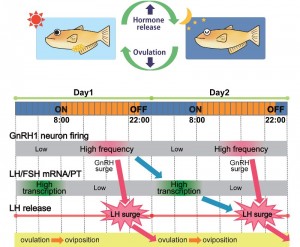Time-of-day-dependent changes in neuronal/hormonal activities


Working hypothesis for the temporal regulation of the ovulatory cycle in the female medaka © Yoshitaka Oka
Toward the evening of Day 1, GnRH1 neuronal activity increases, leading to increased GnRH release. The GnRH peptide stimulates pituitary gonadotropes to release LH within several seconds and causes the LH surge, which triggers ovulation during the night. The GnRH peptide simultaneously acts on the pituitary gonadotropes to increase the transcription of lhb mRNA over the course of several hours, and the synthesized LH will be the source for LH surge on Day 2.
Temporal regulation of reproduction by coordinating endogenous physiological conditions and behaviors is important for successful reproduction. Here, Prof. Oka and his research group at the Department of Biological Sciences, Graduate School of Science, the University of Tokyo, examined the temporal regulation of reproduction by measuring time-of-day-dependent changes in the electrical activity of Gonadotropin-releasing Hormone 1 (GnRH1) peptidergic neurons and in levels of expression of pituitary gonadotropin mRNA using a daily spawning teleost, medaka (Oryzias latipes). They first performed on-cell patch-clamp electrophysiological recordings from GnRH1 neurons that directly project to the pituitary, using gnrh1-green fluorescent protein (GFP) transgenic medaka. The spontaneous firing activity of GnRH1 neurons showed time-of-day-dependent changes: overall, the firing activity in the afternoon was higher than in the morning. They next examined the daily changes in the pituitary gonadotropin transcription level. The expression levels of lhb and fshb mRNA also showed changes related to time of day, peaking during the lights-off period. They finally analyzed effects of GnRH on the pituitary. They demonstrated that incubation of isolated pituitary with GnRH increases lhb mRNA transcription several hours after GnRH stimulation, unlike the well-known immediate LH releasing effect of GnRH. From these results, they propose a working hypothesis concerning the temporal regulation of the ovulatory cycle (equivalent to the human menstrual cycle) in the brain and pituitary of female medaka. Their results provide a promising animal model and a solid working hypothesis for the study of the neuronal/hormonal regulating mechanisms of reproduction in vertebrate species including humans.
Press release (Japanese)
Paper
Tomomi Karigo, Shinji Kanda, Akiko Takahashi, Hideki Abe, Kataaki Okubo ,Yoshitaka Oka
“Time-of-Day-Dependent Changes in GnRH1 Neuronal Activities and Gonadotropin mRNA Expression in a Daily Spawning Fish, Medaka” ,
Endocrinology Online Edition: 2012/April/27 (Japan time), doi: 10.1210/en.2011-2022.
Article link







